If I have mangled fingers and a bottle of Freixenet, it can only mean one thing: Success in the mountains! I completed the Ken Jones Classic, a ski mountaineering race. I climbed up and skied down 3 mountains in 3 hours and 16 minutes.
My day started at 4:15 am rolling out of bed and packing the car up and at 4:55am heading over to the pre-race meeting in Lake Louise. Before the pre race, the route still hadn’t been finalized. Conditions dictate the course which can’t be predicted in advance, so the course was determined at the last-minute and shown to us on big maps at the morning meeting. Also important was to know where the many check-ins were located.
It was a perfect day for high altitude climbing and skiing as the sky was blue and clear allowing great visibility. In clouds or diffuse light we would have had a tough time.
Above: leaving the Bow Valley en route to the first mountain, Whitehorn II.
It was pretty intimidating as this race was mostly professionals and dedicated athletes. Only two other people besides me had real touring gear that you would take out on a multiday expedition. Everyone else had ultralightweight specialized racing gear (and outfits!) It was a mass start so I placed myself in the back of the pack to keep out of the way. After the “get set, go…” the elite racers exploded uphill faster than many people can run on flat ground! The guy in front of me, a fellow first timer I met that morning started laughing to himself in awe I think. I tried not to go too fast which is hard when the whole field bolts uphill so fast. I knew I’d have to keep some reserves but peer pressure got the best of me and I found myself going at a totally unsustainable pace and feeling pretty awful.
Normally when I tour, I go slow enough to take in as much information as possible. By going slow, you don’t have to stop to figure out where and how to navigate safely. This was ingrained into me by one of Canada’s most experienced mountain guides, Cyril Shokoples. He calls it “guide pace” and it allows you to absorb information about snowpack, and calculate your moves by going slow enough to look carefully and process every bit of information. In a race like this, much of these decisions have already been made and the guide pace is out the window! 
Above: left panel shows our first ascent route up the south face of Whitehorn II. Right panel shows the back of Whitehorn II and our descent line as seen from the third and final peak. At the top is a small transition area where you remove your climbing skins and pack them, set your bindings up for descending, and adjusting your boots into a more solid fit. It’s like a pit stop. I was too far behind to see just how fast the pros did their transitions but mine takes about 3 minutes including a quick bite to eat. Clothing changes happen here too as the heart pounding heat generated from climbing is now replaced with a lightning fast descent creating big windchills.
It was a pretty intense drop down into the next valley that was just a little unnerving (past racers said the course last year wasn’t steep enough so the route was modified this year ensuring that all the descents were rated a minimum of double black diamond) At the bottom was a check-in and another transition back to climbing set up. The route steeply ascended what is labeled in the picture as “2nd Peak” This peak is unnamed but has a couple of unofficial local names. By this point I was starting to become pretty tired and found myself already activating some of my coping mechanisms for physical misery learned from countless years in the wilds. As far as physical techniques go, I was already starting to use the “rest step” which is a very subtle pause in the gate that allows a micro second of rest in alternating legs. It sounds simple but takes practice to use fluidly and efficiently. Once at the top of Peak 2, I again did the switchover to descent gear and gave myself an extra minute of rest at the top to let my legs reset. It can take a ton of leg strength on steep descents in heavy snow so I wanted to make sure I was ready for it. I skied the gully very cautiously.
At the bottom of the valley, yet another check-in and transition back to climbing set up.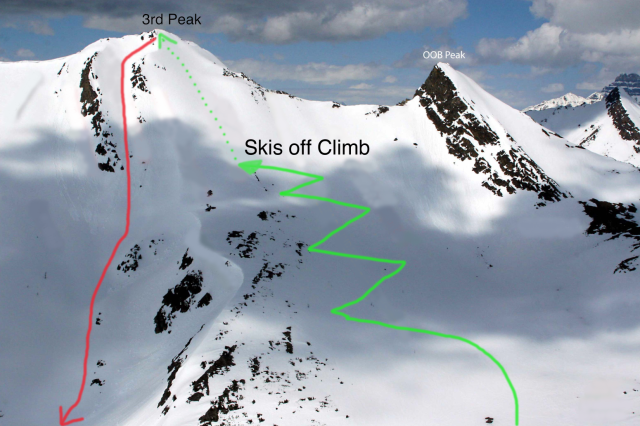
Above: The third and final peak some call Brownshirt. Hairshirt Peak would have been a better name for it. This final test had a real sting in its tail. You ski up the lateral moraine but then as the mountain steepens, you have to take your skis off, fix them to your pack and climb the final pitch. There was a flattened square about 2 metres square dug into the slope to accomplish this transition more easily. You really have to affix the skis solidly to the pack and have the pack bolted tightly to you person so that there’s no “swing back” pulling you backwards and cartwheeling you down the steep slope. As it was, I had to mind my balance pretty well. My poles are adjustable so that they can be shortened to just a couple of feet to act as a good snow tool for maintaining balance in super steep climbs. A grueling climb not just because of the high altitude, not just because of the steepness but because we’d already climbed two peaks! At the finish line, this “boot-pack” section as it’s called was monopolizing most of the conversation. But it’s what makes it a true ski mountaineering route.
I found it impossible to go more than 10 or 15 steps up the “boot pack” without a quick 2 or 3 second pause. At the top was a check-in with one of the ski patrollers from Lake Louise who offered plenty of encouragement for the last few dozen vertical meters. I was amazed when I had to pause about 2m from the top! I just couldn’t climb up that last 2m without a micro rest. The lone patroller sensed a little frustration in that moment and said that just this single climb nearly killed him and that he couldn’t imagine doing all three. We had a pleasant chat while I did my gear transition and he gave me some beta on the steep gully I was about to drop into. My last hair-raising descent of the day would take me into the Skoki Valley. After a checkpoint in the valley, it was a 7km ski down the gentle valley with just a couple easy and mercifully short uphills to overcome before arriving back in the Bow Valley at the base of the Lake Louise Ski Area.
One of the interesting side stories for me throughout the day deserves mention. Suz had to be in Calgary at 3pm for her good friend’s stagette party she organized. So she was going to drive up to Louise around when we thought I’d cross the finish line but would have to leave by 12:30pm. Not knowing the course in advance made it tricky to guess how long it would take me. But as I passed through the checkpoints I started to worry that I wasn’t going to finish in time to have Suzanne there. It was an extra incentive when I was gasping for limited air at altitude! I casually mentioned this at one of the checkpoints and word seemed to spread back to the finish line (they’re all on handheld radios) At one of the middle checkpoints the guy checked off my number and said “she’s still there!” After that I got updates at each checkpoint that she was still at the finish line!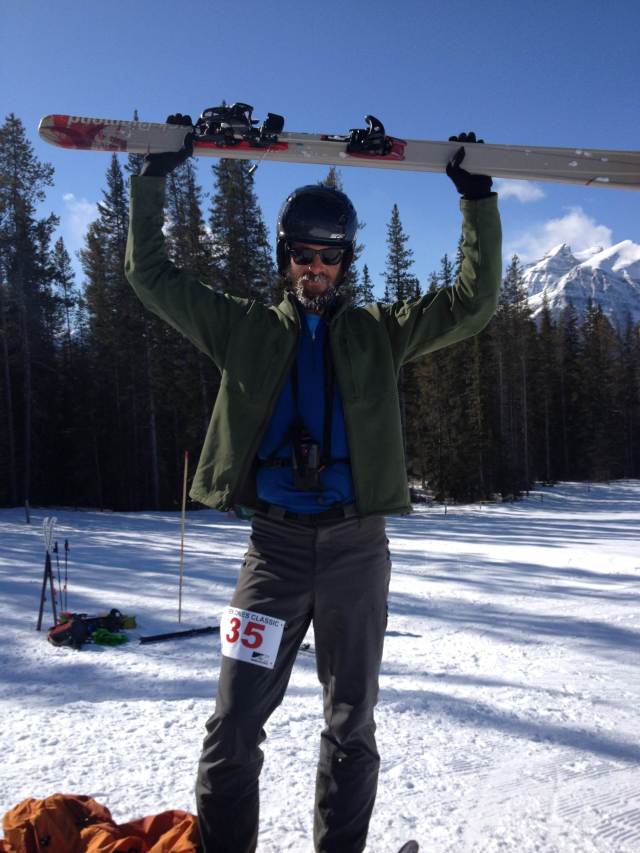
Above: The finish line! I crossed just in time to get a big hug from Suz before she had to leave. It’s hard to call the race an enjoyable experience when it was such a grueling grind but it was interesting to push hard to see just how much I could give. The other competitors were all very friendly even the elite athletes were all very supportive. I met a couple of them at the previous stop on the ski mountaineering race “tour” in Golden, BC last week and they were very supportive for my first try. But as with most of these things organized or otherwise, it was satisfying to set out a new challenge and attack it square on.
———————————————————————
rough race elevation profile and distances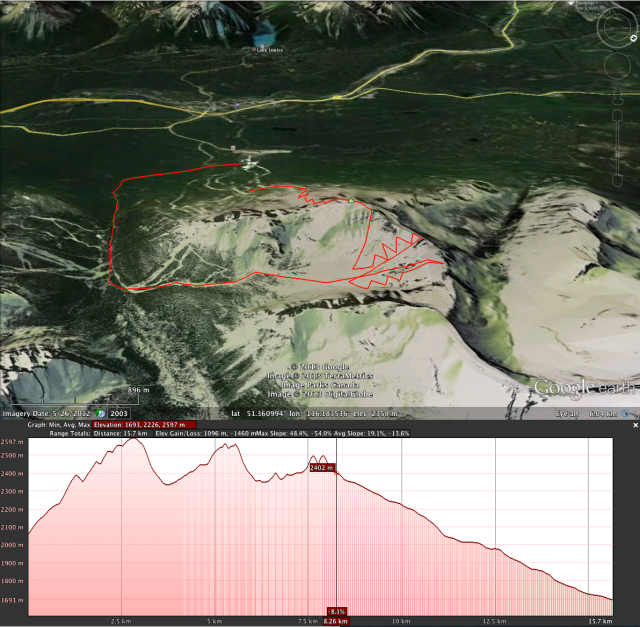
Mandatory gear you must carry for the race includes avalanche transceiver, emergency bivouac shelter, probe and rescue shovel, helmet and extra clothing. Food and water adds even more weight. Transceiver checks were done at race start and gear checks were done at finish line.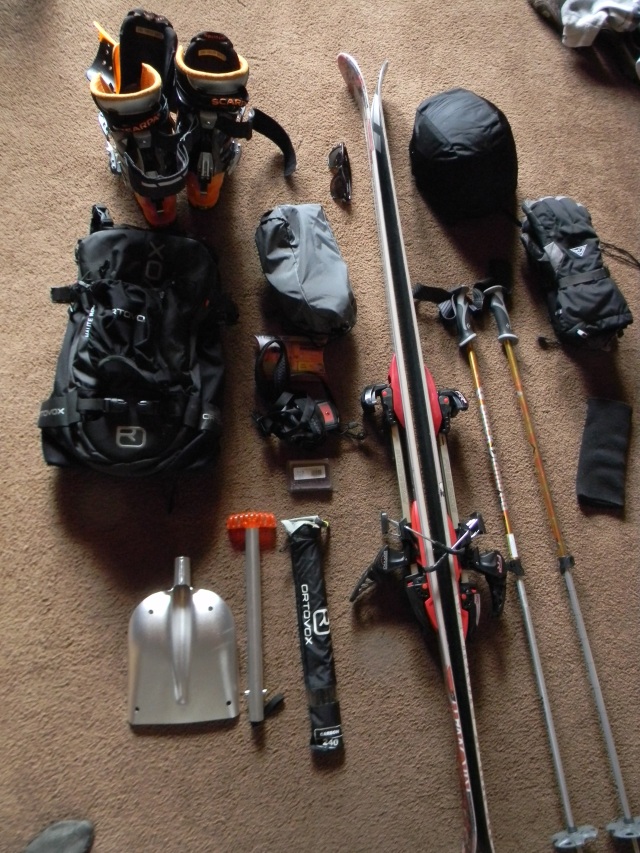
As a humourous aside, by the time I got home I was pretty much all in so you can imagine my horror to discover I had lost my keys and Suzanne was out of town! I collapsed in a heap at the front door and went through every pocket and came up empty. I went back to the car to see if I had stashed them someplace stupid when I found them half buried in the snow in the driveway where they fell out of my pocket at 4:55 am.
I may not have won the race but I’ll take that bit of luck for a prize most days!
pps my finger got caught in my binding while I was converting it into free heel climbing mode. Finger manglement seems to be my constant price of admission!

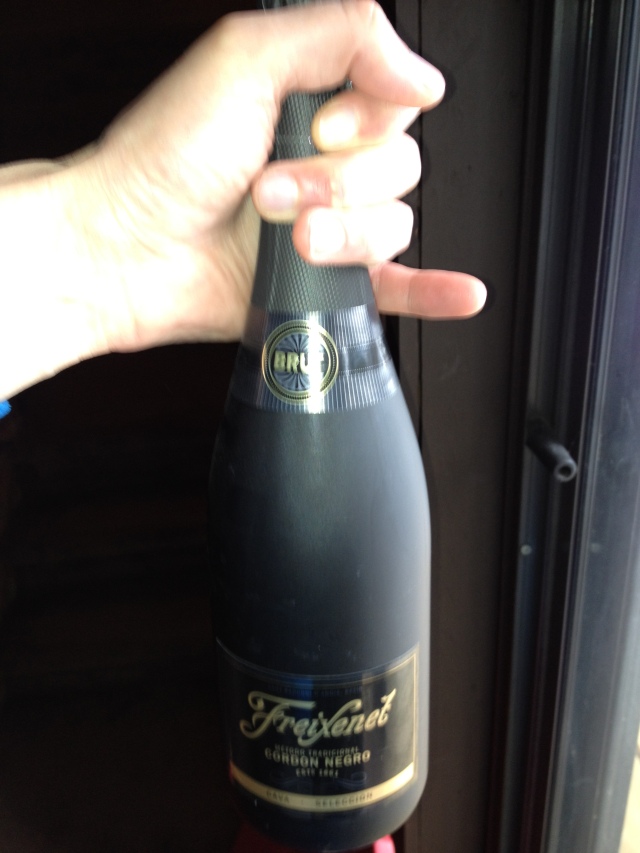

What a great adventure and well told! Having enjoyed the pain and exhilaration of more long distance runs now and making the acquaintanceship of many casual endurance runners, I find that everyone takes extraordinary interest in telling and listening to stories where the main theme is injury, pain and discomfort and how to cope with it via all the mental battles and wars raging within and the deep satisfaction, fortified by post race dopiness, that one enjoys and so I particularly enjoyed reading and identifying with the race struggles and conquests.
Yes the internal dialogue that goes through your head is unique under these circumstances. For the first half hour I found myself trying to figure out why I was in this situation and trying to find an answer good enough to motivate me to ignore the pain in my legs and guts. It’s strange that this dialogue didn’t happen until I was in the race itself! An odd time to justify it. After that I recall thinking about whether I would be able to do the last mountain at all? To combat this doubt, I pictured putting my race bib up on the wall of my gear room at home. If I didn’t complete the course, that bib would look really foolish on the wall. That worked pretty well to get my mind off that thought and focus on smooth motion and efficient climbing, getting mesmerized by the ryhthm.
I really enjoyed observing that, in what seems like an overwhelmingly individual endeavor, there is so much evidence of teamwork. I felt that in my marathon as well.
This might be hard to believe, but Dave’s just a regular Joe. He just wants to be happy.
Hi Dave, only found your report about the LL race now. Well written!
I am glad you enjoyed the experience despite having to do it on much bigger gear than most of us. But that is exactly how pretty much all of us started to skimo race, but we are spoiled now and wouldn’t go back 🙂